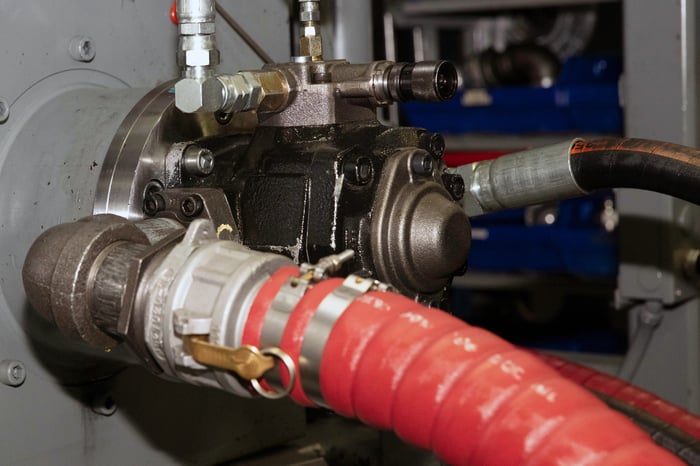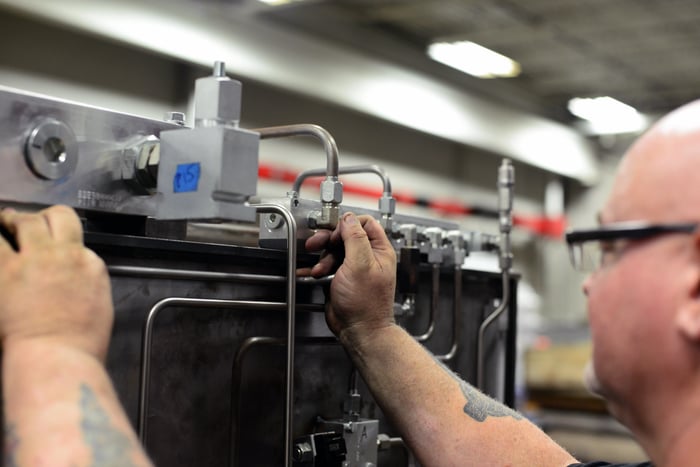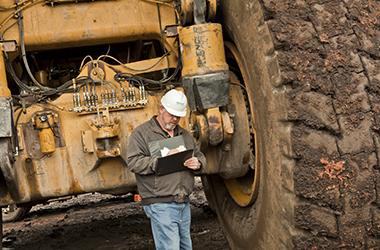Detecting and Correcting External Hydraulic Leaks
Keep your system running smoothly by keeping it free of compromising external leaks
With collaboration from Engineered Sales. Image above provided by Spencer Fluid Power.
Problems Caused by External Leaks
External leaks can cause many problems, which can affect your bottom line, the safety of your workers, or even cause environmental contamination. Some of the most prominent problems are:
Wasted fluid
First and foremost is wasted fluid. Every drop that leaves the machine is another drop that must be purchased and added back into the reservoir.
Heat generation
Low fluid levels can cause the hydraulic system to run hot, which can cause other problems, such as varnish build up or premature hose & seal failure. For more information see Keeping Hydraulic Oil Cool.
Ecological contamination/hazards
For mobile equipment, leaked fluid can contaminate the local ecosystem, which can be costly to clean up. Small leaks, or those caught quickly, will cause minimal damage, but larger leaks could pose a significant ecological risk. In industrial applications, hydraulic oil building up on the floor can cause slip and fall accidents, which are still one of the leading cause of injuries at work.
System contamination
External leaks are bridges between the outside environment and the hydraulic fluid. If the break is large enough to allow fluid out, then particulates can potentially get in. Contaminated fluid can cause a host of problems in hydraulic systems and is one of the main causes of system degradation and failure. This is especially true in mobile applications where the machine is often operating in dirty conditions.
 Points on any machine with a lot of connections, such as the one pictured here have many leak points and need to be carefully monitored for external leaks.
Points on any machine with a lot of connections, such as the one pictured here have many leak points and need to be carefully monitored for external leaks.
Finding External Leaks
Periodic checks
An integral part of the maintenance program of every machine is to periodically check the system for leaks. This can be done easily with a visible inspection. Start the machine, put it under pressure and then visually inspect it, looking at all hoses and connection points looking for fluid leaks or drips. Also keep an eye out for any puddles or abnormal wetness on the ground beneath the machine are good indicators of external leakage
Note that this step of your hydraulic maintenance will require starting with a clean, dry machine. Dirt covering the machine could obscure the source of the leak and dripping water may appear to be a fluid leak.
Fluid level tracking
Keeping track of the fluid levels in the machine is a good way to be apprised of leaks as external leaks will result in lower system fluid levels. Keeping good records will aid this process. Keeping track of the date and amount of any fluid replenishment over time will allow you to understand how much fluid your system is losing during normal operation. Knowing this will help you identify breaks in the trend which could indicate a leak in the system and could assist your preventative maintenance efforts.
 A careful visual inspection of your machine, focusing on the connection points, is a good way to find external leaks. Just be sure the machine is clean and dry, or it may be hard to see the source of the leak.
A careful visual inspection of your machine, focusing on the connection points, is a good way to find external leaks. Just be sure the machine is clean and dry, or it may be hard to see the source of the leak.
Finding the source of the leak
Be careful when determining the location of the leak as the fluid may be dripping from other parts of the machine. For example, the connection between hose and a valve may be wet and dripping, when really the hose is split in the middle and the fluid is running down the length of the hose before finally dripping off at the connection point.
Fixing External Leaks
Understand the cause of the failure
The obvious fix is to replace the damaged part, but care should be taken to understand the cause of failure. If good records are kept, then the age of the failed part should be readily available. If the lifespan lines up with manufacturer’s specs, then there may not be cause for concern. But if the seal or connection is failing well in advance of its predicted end-of-life, then there may be some other factor causing it to degrade more quickly.
Determining what exactly that factor is will allow you to increase the life of your machine by using a more suitable replacement. If you need help in this effort, please contact your Applied Fluid Power Representative for help troubleshooting your system.
Correct cause of failure if possible
In some cases, steps may be taken to prevent the same failure from happening in the future. Hose abrasion is one such instance. If the hose failed due to abrasive contact with other components of the machine, then an abrasion sleeve or more careful routing could prevent the same damage. Or perhaps the seal you are using in your machine isn’t best suited to your fluid, in which case you may need to replace it with a seal that is more compatible with the chemical or temperature of your system.
Get Connected TodayTackle hydraulic leaks head on by taking preventative measures and replacing faulty equipment. Let us help you better manage your hydraulic leaks. |

|


